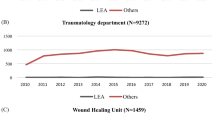Abstract
Introduction: Limb loss has a devastating effect on patients. To know the underlying causes of limb amputation would be helpful in planning public health strategies in the country. The objectives of this study are (1) to identify the primary causes and the feature of limb amputations in the setting of a university hospital, and (2) to study the time trends of the causes of limb amputation over a period of 5 years. Materials and methods: The clinical and pathological data from 216 amputated limbs submitted to the Pathology Department of Chiang Mai University Hospital from 2000 to 2004 were reviewed. Results: Of these, 188 cases were first time amputations, and 28 cases were repeat amputations. The 188 first amputated specimens included 23 upper limbs (12%) and 165 lower limbs (88%), from 115 male (61%) and 73 female (39%) patients. Dysvascular (46%), tumor-related (36%), and infection-related (10%) amputations were the three most common scenarios. The rate of amputation was high in 2004 (32%) owing to an unexpected increase in the numbers of dysvascular amputation. Atherosclerosis accounted for at least 52% of dysvascular amputations. The leading cause of tumor-related amputations was sarcoma (72%), almost half of which were osteosarcomas. The major cause of lower limb amputation was dysvascular (51%) whereas that of upper limb amputation was tumor related (61%). Subgroup analysis of the major limb amputations revealed that 44% were tumor related, 39% were dysvascular, and 8% were infection-related causes. The proportion of major limb losses in the tumor-related group (87%, 59/68) was significantly higher than those in the dysvascular group (62%, 53/86) (P=0.001). In addition, the proportion of upper limb losses in the tumor-related group (21%, 14/68) was significantly greater than those in the dysvascular group (2%, 2/86), (P<0.001). The causes of 28 repeat amputations were similar, i.e., dysvascular (61%), tumor related (29%), and infectious related (7%). Conclusion: (1) Atherosclerosis, a potentially preventable disease is responsible for the great proportion of limb losses in Northern Thailand; (2) the numbers of dysvascular amputation seem to be increasing; (3) tumor, especially sarcoma, is the most common cause of major limb amputations as well as upper limb loss.



Similar content being viewed by others
References
Aulivola B, Hile CN, Hamdan AD, Sheahan MG, Veraldi JR et al (2004) Major lower extremity amputation: outcome of a modern series. Arch Surg 139:395–399 (Discussion 9)
Chen SY, Chie WC, Lan C, Lin MC, Lai JS, Lien IN (2002) Rates and characteristics of lower limb amputations in Taiwan, 1997. Prosthet Orthot Int 26:7–14
Dillingham TR, Pezzin LE, MacKenzie EJ (2002a) Limb amputation and limb deficiency: epidemiology and recent trends in the United States. South Med J 95:875–883
Dillingham TR, Pezzin LE, Mackenzie EJ (2002b) Racial differences in the incidence of limb loss secondary to peripheral vascular disease: a population-based study. Arch Phys Med Rehabil 83:1252–1257
Ekere AU (2003) The scope of extremity amputations in a private hospital in the south-south region of Nigeria. Niger J Med 12:225–228
Ephraim PL, Dillingham TR, Sector M, Pezzin LE, Mackenzie EJ (2003) Epidemiology of limb loss and congenital limb deficiency: a review of the literature. Arch Phys Med Rehabil 84:747–761
Hazmy W, Mahamud M, Ashikin N, Jamilah S, Yee LE, Shong HK (2001) Major limb amputations in Seremban Hospital: a review of 204 cases from 1997–1999. Med J Malaysia 56(Suppl C):3–7
Lazlo G, Belicza E, Kullmann L (1999) Lower limb amputations during 3 years in Hungary. Arch Orthop Trauma Surg 119:94–97
Maitra A, Abbas AK (2005) The endocrine system. In: Kumar V, Abbas AK, Fausto N (eds) Robbins and Cotran. Pathologic basis of disease. Elsevier Saunders, Philadelphia, pp 1155–1226
Mitchell RN (2005) Hemodynamic disorders, thromboembolic disease, and shock. In: Kumar V, Abbas AK, Fausto N (eds) Robbins and Cotran. Pathologic basis of disease. Elsevier Saunders, Philadelphia, pp 119–144
Ogunlade SO, Alonge TO, Omololu AB, Gana JY, Salawu SA (2002) Major limb amputation in Ibadan. Afr J Med Med Sci 31:333–336
Onuminya JE, Obekpa PO, Ihezue HC, Ukegbu ND, Onabowale BO (2000) Major amputations in Nigeria: a plea to educate traditional bone setters. Trop Doct 30:133–135
Schoen FJ (2005a) Blood vessels. In: Kumar V, Abbas AK, Fausto N (eds) Robbins and Cotran. Pathologic basis of disease. Elsevier Saunders, Philadelphia, pp 511–554
Schoen FJ (2005b) The heart. In: Kumar V, Abbas AK, Fausto N (eds) Robbins and Cotran. Pathologic basis of disease. Elsevier Saunders, Philadelphia, pp 555–618
Solagberu BA (2001) The scope of amputations in a Nigerian teaching hospital. Afr J Med Med Sci 30:225–227
Acknowledgements
We would like to thank Kornkanok Suvanarat, Chanpen Uchareoun, and Natetaya Sakarnkit for extracting the cases and the data from the file. We declare that this study comply with the current laws of Thailand.
Author information
Authors and Affiliations
Corresponding author
Rights and permissions
About this article
Cite this article
Settakorn, J., Rangdaeng, S., Arpornchayanon, O. et al. Why were limbs amputated? An evaluation of 216 surgical specimens from Chiang Mai University Hospital, Thailand. Arch Orthop Trauma Surg 125, 701–705 (2005). https://doi.org/10.1007/s00402-005-0060-y
Received:
Published:
Issue Date:
DOI: https://doi.org/10.1007/s00402-005-0060-y




